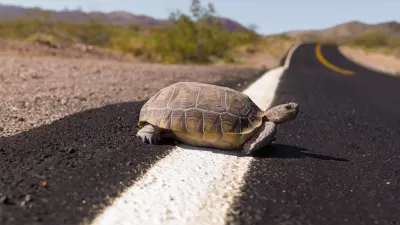A new book spotlights how bird-friendly design makes for healthier and more pleasant cities for all species.

Urban design takes into account many factors, writes Nate Berg, but one author argues a crucial element has been left out of traditional design discussions: the birds.
Up to one billion birds die from collisions with buildings every year, and urban environments are typically hostile to bird populations. In The Bird-Friendly City: Creating Safe Urban Habitats, Timothy Beatley points out all the ways that cities can be more bird-friendly and, he argues, more human-friendly as well. From small tweaks to major design changes, Beatley's book shows how birds and other urban wildlife can be integrated into design choices that make cities healthier for everyone. "Better integrating nature into cities is good for people, but our buildings and cities aren’t always built in a way that’s good for nature." Every urban development project is an opportunity to design with birds in mind. "Beyond just reducing hazards we need to recognize that cities can be a positive force on behalf of birds, and for the conservation of biodiversity more generally."
Abundant bird life, writes Beatley, creates "soul-nourishing cities." To promote environments that are pleasant and nurturing to all species, he recommends minimum standards for biodiversity in all new buildings or developments and suggests replacing our traditional narrow indicators of a city's success with broader goals and metrics that include nature and biodiversity as core values.
FULL STORY: Why cities should be designed for birds

Alabama: Trump Terminates Settlements for Black Communities Harmed By Raw Sewage
Trump deemed the landmark civil rights agreement “illegal DEI and environmental justice policy.”

Planetizen Federal Action Tracker
A weekly monitor of how Trump’s orders and actions are impacting planners and planning in America.

The 120 Year Old Tiny Home Villages That Sheltered San Francisco’s Earthquake Refugees
More than a century ago, San Francisco mobilized to house thousands of residents displaced by the 1906 earthquake. Could their strategy offer a model for the present?

In Both Crashes and Crime, Public Transportation is Far Safer than Driving
Contrary to popular assumptions, public transportation has far lower crash and crime rates than automobile travel. For safer communities, improve and encourage transit travel.

Report: Zoning Reforms Should Complement Nashville’s Ambitious Transit Plan
Without reform, restrictive zoning codes will limit the impact of the city’s planned transit expansion and could exclude some of the residents who depend on transit the most.

Judge Orders Release of Frozen IRA, IIJA Funding
The decision is a victory for environmental groups who charged that freezing funds for critical infrastructure and disaster response programs caused “real and irreparable harm” to communities.
Urban Design for Planners 1: Software Tools
This six-course series explores essential urban design concepts using open source software and equips planners with the tools they need to participate fully in the urban design process.
Planning for Universal Design
Learn the tools for implementing Universal Design in planning regulations.
Clanton & Associates, Inc.
Jessamine County Fiscal Court
Institute for Housing and Urban Development Studies (IHS)
City of Grandview
Harvard GSD Executive Education
Toledo-Lucas County Plan Commissions
Salt Lake City
NYU Wagner Graduate School of Public Service





























